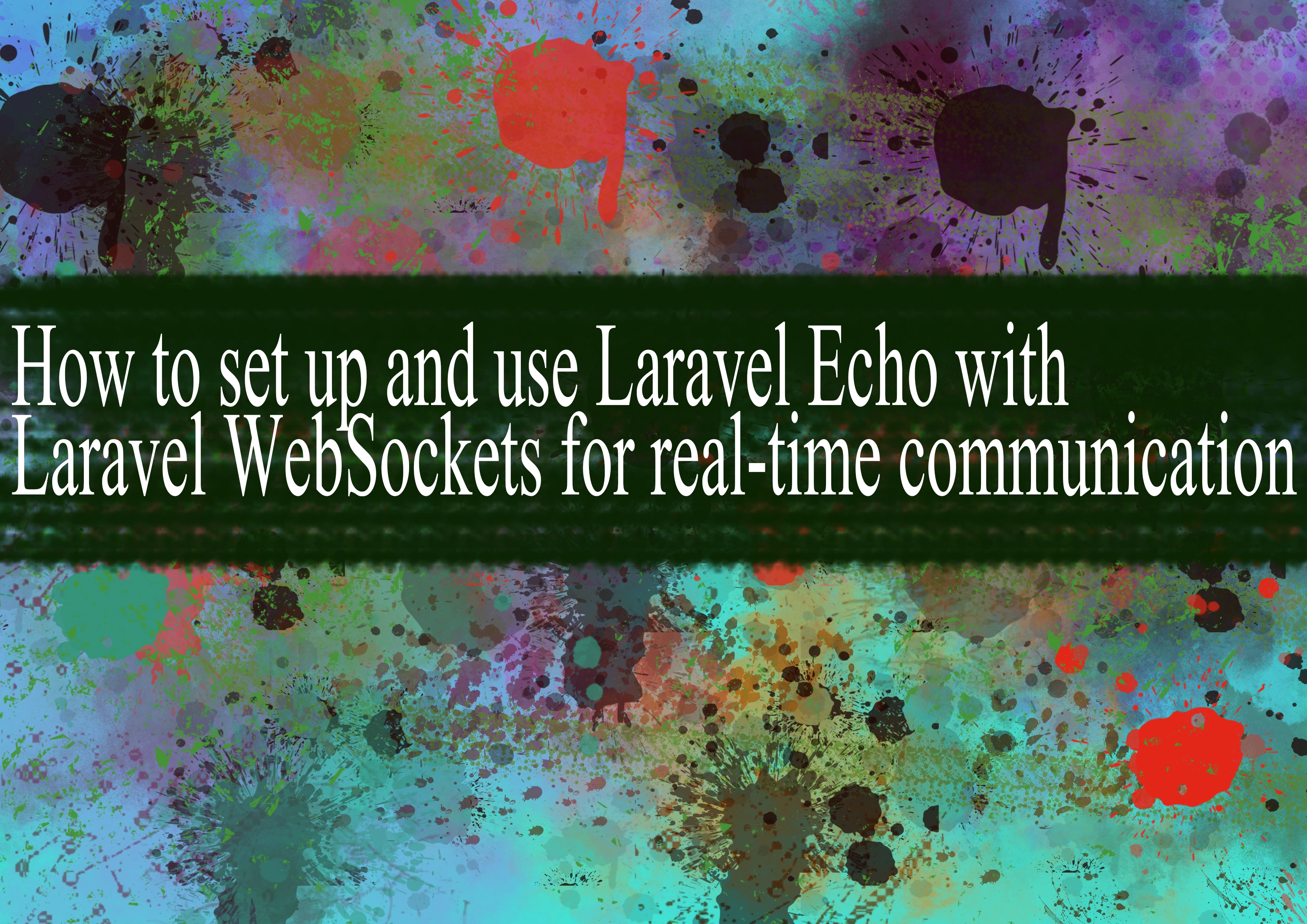How to set up and use Laravel Echo with Laravel WebSockets for real-time communication

Setting up Laravel Echo with Laravel WebSockets for real-time communication involves several steps. Laravel Echo is a JavaScript library that makes it easy to work with WebSockets and other real-time communication technologies. Laravel WebSockets is a package for Laravel that provides the server-side functionality for handling WebSocket connections. Here's a step-by-step guide to help you set up and use Laravel Echo with Laravel WebSockets:
Step 1: Install Laravel Echo and Laravel WebSockets
Make sure you have a Laravel project set up. If not, you can create one using the following command:
bashcomposer create-project --prefer-dist laravel/laravel your-project-name
Then, install Laravel Echo and Laravel WebSockets:
bashcomposer require pusher/pusher-php-server
composer require beyondcode/laravel-websockets
Step 2: Configure Laravel WebSockets
After installing Laravel WebSockets, you need to publish its configuration file and migrate the database:
bashphp artisan vendor:publish --provider="BeyondCode\LaravelWebSockets\WebSocketsServiceProvider" --tag="migrations"
php artisan migrate
Next, update your .env file with the WebSocket configuration:
envPUSHER_APP_ID=null PUSHER_APP_KEY=null PUSHER_APP_SECRET=null PUSHER_APP_CLUSTER=null
Add the following lines to your .env file to configure Laravel WebSockets:
envBROADCAST_DRIVER=pusher PUSHER_APP_ID=your-pusher-app-id PUSHER_APP_KEY=your-pusher-app-key PUSHER_APP_SECRET=your-pusher-app-secret
Step 3: Configure Laravel Echo
Include Laravel Echo and Pusher in your project by adding the following lines to your resources/js/bootstrap.js file:
javascriptimport Echo from 'laravel-echo';
window.Pusher = require('pusher-js');
window.Echo = new Echo({
broadcaster: 'pusher',
key: process.env.MIX_PUSHER_APP_KEY,
cluster: process.env.MIX_PUSHER_APP_CLUSTER,
encrypted: true,
});
Step 4: Set Up Broadcasting
Update your config/broadcasting.php file to use the Pusher driver for broadcasting:
php'connections' => [
'pusher' => [
'driver' => 'pusher',
'key' => env('PUSHER_APP_KEY'),
'secret' => env('PUSHER_APP_SECRET'),
'app_id' => env('PUSHER_APP_ID'),
'options' => [
'cluster' => env('PUSHER_APP_CLUSTER'),
'encrypted' => true,
],
],
],
Step 5: Create a Broadcasting Event
Create a broadcasting event that will be sent to the WebSocket server. For example, you can create an event using the following command:
bashphp artisan make:event YourEventName
Update the generated event class with the data you want to broadcast.
Step 6: Broadcast the Event
In your controllers or wherever you want to trigger the event, use the event function to broadcast the event:
phpevent(new YourEventName($data));
Step 7: Listen for Events in JavaScript
In your JavaScript components, you can listen for events using Laravel Echo. For example, you can use the following code in a Vue component:
javascriptmounted() {
Echo.channel('channel-name')
.listen('YourEventName', (event) => {
console.log(event);
});
}
Step 8: Start Laravel WebSockets Server
Run the Laravel WebSockets server using the following command:
bashphp artisan websockets:serve
Additional Resources:
- Laravel WebSockets Documentation: https://docs.beyondco.de/laravel-websockets/
- Laravel Echo Documentation: https://laravel.com/docs/8.x/broadcasting
- Pusher Documentation: https://pusher.com/docs
Make sure to check the documentation for the latest updates and additional features.
-
Popular Post
- How to optimize for Google's About This Result feature for local businesses
- How to implement multi-language support in an Express.js application
- How to handle and optimize for changes in mobile search behavior
- How to handle CORS in a Node.js application
- How to use Vue.js with a UI framework (e.g., Vuetify, Element UI)
- How to configure Laravel Telescope for monitoring and profiling API requests
- How to create a command-line tool using the Commander.js library in Node.js
- How to implement code splitting in a React.js application
- How to use the AWS SDK for Node.js to interact with various AWS services
- How to use the Node.js Stream API for efficient data processing
- How to implement a cookie parser middleware in Node.js
- How to implement WebSockets for real-time communication in React
-
Latest Post
- How to implement a dynamic form with dynamic field styling based on user input in Next.js
- How to create a custom hook for handling user interactions with the browser's device motion in Next.js
- How to create a custom hook for handling user interactions with the browser's battery status in Next.js
- How to implement a dynamic form with dynamic field visibility based on user input in Next.js
- How to implement a dynamic form with real-time collaboration features in Next.js
- How to create a custom hook for handling user interactions with the browser's media devices in Next.js
- How to use the useSWRInfinite hook for paginating data with a custom loading indicator in Next.js
- How to create a custom hook for handling user interactions with the browser's network status in Next.js
- How to create a custom hook for handling user interactions with the browser's location in Next.js
- How to implement a dynamic form with multi-language support in Next.js
- How to create a custom hook for handling user interactions with the browser's ambient light sensor in Next.js
- How to use the useHover hook for creating interactive image zoom effects in Next.js